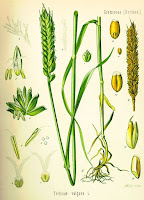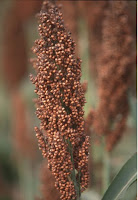World Cereal Production
Production in millionton per grain variety
No.
|
Grain variety
|
1994-1995
|
1999-2000
|
2003-2004
|
1.
|
Maize
|
569.5
|
590.8
|
705.3
|
2.
|
Rize
|
534.7
|
598.4
|
608.5
|
3.
|
Wheat
|
495.6
|
576.3
|
586.5
|
4.
|
Barley
|
160.8
|
131.9
|
155.1
|
5.
|
Sorghum
|
6010.9
|
58.5
|
60.2
|
6.
|
Durum
|
30.6
|
34.1
|
37.6
|
7.
|
Millet
|
25.9
|
27.2
|
27.7
|
8.
|
Oats
|
33.7
|
25.9
|
26.9
|
9.
|
Rye
|
22.5
|
19.9
|
19.5
|
10.
|
Triticale
|
11.4
|
9.4
|
13.7
|
11.
| MIxes |
8.7
|
6.2
|
7.3
|
Total
|
1954.3
|
2078.6
|
2249.3
| |
They were domesticated
in Mesoamerica (Mexico and Central America). Maize development is thought to
have started from 7,500 t0 12,000 years ago. Maize then was brought to North
America. The US is still the biggest producer of Maize, with almost half of the
world harvest. Maize was brought to Europe during the exploration of the Americas
in the 16th and 17th centuries. Used mainly as feed, Maize has the highest harvest
volume worldwide with over 600 Mio. Tons.
Maize Biggest Producers :
No.
|
Country
|
Total
(mio. tons)
|
1.
|
USA
|
280
|
2.
|
China
|
133
|
3.
|
Brazil
|
35
|
4.
|
Mexico
|
20
|
5.
|
Argentina
|
19
|
6.
|
India
|
15
|
7.
|
France
|
13
|
8.
|
Indonesia
|
12
|
9.
|
South Africa
|
12
|
10.
|
Italy
|
11
|
11.
|
Romania
|
9.9
|
12.
|
Hungary
|
9.0
|
Maize (Corn) : Usage for Human consumption
- Corn Starch
- Corn flakes
- Sweet Corn (Salds/Vegetables)
- Oil from maize germ
- Corn Soup
- Mais Semolina (Polenta ; Famous in Italy)
Rice
is one of the world's most consumed grains, representing around half of the
human population's dietary intake. In the region around the eastern Indian
Ocean, rice farming is said to have begun around 6,500 years ago. Africa and
Asia were the main farming areas. Rice production volume is comparable to that
of wheat, and it can be classified as either number 2 or 3 based on the year of
harvest. World production of paddy rice rose substantially throughout the
decades from approximately 200 million tons in 1960 to 600 million tons in
2004.
Top 12 Producers [2005]
No.
|
Country
|
Total
(mio. tons)
|
1.
|
China
|
185
|
2.
|
India
|
129
|
3.
|
Indonesia
|
54
|
4.
|
Bangladesh
|
40
|
5.
|
Vietnam
|
36
|
6.
|
Thailand
|
27
|
7.
|
Myanmar
|
25
|
8.
|
Philippines
|
15
|
9.
|
Brazil
|
13
|
10.
|
Japan
|
11
|
11.
|
USA
|
10
|
12.
|
Pakistan
|
7.3
|
- The seeds of the rice plant (paddy) are first milled to remove the outer husks of the grain; this creates brown rice.
- Pearling and polishing is removing the germ and the rest of the husk, called bran, creating white rice.
- The processed rice is usually steamed of fried.
- Other finished products are :
Without a doubt,
wheat is the most important staple crop in the world, besides rice and maize.
Cultivation began in Mesopotamia perhaps around 9000 years ago (today Iran,
Irak, Syria). From Egypt, it went to Europe. The production of wheat is
comparable to rice production, with wheat production ranging between 600 and
700 million tons. The gluten protein level in wheat is the single factor that
stops the bread from being worked into other grains.
Wheat Biggest Producers
Top 12 Producers [2005]
No.
|
Country
|
Total
(mio tons)
|
1.
|
China
|
96
|
2.
|
India
|
72
|
3.
|
USA
|
57
|
4.
|
Russia
|
48
|
5.
|
France
|
37
|
6.
|
Canada
|
25
|
7.
|
Australia
|
24
|
8.
|
Germany
|
24
|
9.
|
Pakistan
|
22
|
10.
|
Turkey
|
21
|
11.
|
Ukraine
|
19
|
12.
|
Argentina
|
16
|
Source : http://www.geohive.com/global/geo.php?xml=ag_wheat&xsl=ag
- Mainly Flour (For Bread, For Noodles, For Confectionary)
- Semolina
- Puffed Wheat
- Cereals
Barley is an
important staple meal for both humans and animals. The Cultivation process
started in Mesopotamia about 2000 BC. The number of kernel rows in the head can
be used to partition barley. Two-row barley, four-row barley, and six-row
barley have all been farmed. Wild barley has two rows, as does the first
two-row barley.
In contrast to
six-row barley, two-row barley has a lower protein level but a higher enzyme
content. For animal feed or malt that has important adjunct content, we
recommend high protein barley. Two-row barley is better suitable for malts
containing no adjuncts. Four-row (also known as staggered growth) is
unacceptable for brewing.
No.
|
Country
|
Total
(mio tons)
|
1.
|
Russia
|
15.8
|
2.
|
Canada
|
12.1
|
3.
|
Germany
|
11.7
|
4.
|
France
|
10.4
|
5.
|
Ukraine
|
9.0
|
6.
|
Turkey
|
9.0
|
7.
|
Australia
|
6.6
|
8.
|
UK
|
5.5
|
9.
|
USA
|
4.6
|
10.
|
Spain
|
4.4
|
11.
|
Denmark
|
3.7
|
12.
|
Poland
|
3.5
|
- Beer
- Malt Whiskey
- Barley Flakes/ Cereals
Sorghum is a
tropical cereal grass that is farmed (like rice and Maize). An important cereal
crop was first cultivated in Africa and is now the world's fifth-most widely
cultivated cereal crop. Sorghum grains are almost identical to Maize in their
overall structure. They have greasy endosperm with a little germ, respectively.
Sorghum is about 75% starch, 12% protein, 5% Fibre, 4% Fat, and 4% minerals.
African sorghum
production has expanded from 11.6 million tons to 21 million tons over the past
quarter-century.
Sorghum Biggest Producers :
Top 12 Producers [2005]
No.
|
Country
|
Total
(mio tons)
|
1.
|
USA
|
9.8
|
2.
|
Nigeria
|
8.0
|
3.
|
India
|
8.0
|
4.
|
Mexico
|
6.3
|
5.
|
Sudan
|
4.3
|
6.
|
Argentina
|
2.9
|
7.
|
China
|
2.6
|
8.
|
Ethiopia
|
1.8
|
9.
|
Australia
|
1.7
|
10.
|
Brazil
|
1.5
|
11.
|
Burkina
Faso
|
1.4
|
12.
|
Egypt
|
0.95
|
- Porridge
- Bread
- Pancakes
- Dumplings
- Couscous
- Breakfast cereals (Puffed)
- Beer
Durum comes from the
Latin word durum, which means "hard." Durum is a popular pasta-making
grain because of its toughness. In addition, durum wheat has a high protein
content and a strong gluten structure, making it ideal for pasta and bread.
Amber-coloured durum kernels stand out among the red wheat grains. Because
durum wheat is unique, its endosperm is not creamy white but yellow; pasta with
this flour takes on a bright yellow colour.
Durum Biggest Producers
Top 12 Producers [2003]
No.
|
Country
|
Total
(mio tons)
|
1.
|
Italy
|
4.2
|
2.
|
Canada
|
3.7
|
3.
|
Syria
|
2.8
|
4.
|
Turkey
|
2.3
|
5.
|
Spain
|
1.9
|
6.
|
France
|
1.6
|
7.
|
India
|
1.4
|
8.
|
Russia
|
1.2
|
9.
|
Mexico
|
1.1
|
10.
|
Morocco
|
1.0
|
11.
|
Algeria
|
0.9
|
12.
|
Greece
|
0.8
|
- Pasta
- Couscous
- Bread
- Pearl (bulrush) millet
- Finger millet
- Prosso (golden millet) millet
- Fox tail millet
- Japanese millet
- Teff millet
- Koda (ditch millet)
- Brown top millet
- plus for other species of limited importance
No.
|
Country
|
Total
(mio tons)
|
1.
|
India
|
9.00
|
2.
|
Nigeria
|
6.28
|
3.
|
China
|
2.10
|
4.
|
Niger
|
2.10
|
5.
|
Mali
|
0.97
|
6.
|
Burkina
Faso
|
0.94
|
7.
|
Uganda
|
0.70
|
8.
|
Senegal
|
0.69
|
9.
|
Sudan
|
0.66
|
10.
|
Russia
|
0.46
|
11.
|
Ukraine
|
0.32
|
12.
|
Ethiopia
|
0.31
|
- Estimated 20 mio. tons are used for Food purpose
- 90% of human consumption in developing countries
- Bread (Chapatti)
- Porridge
Oats were
domesticated relatively late compared to other grains in Eurasia. Grapes are
found in every climatic zone. Wheat, rye, and barley all have lower heat
requirements in the summer and can tolerate rain better than these other
grains. It is believed that eating oat bran helps lower "bad"
cholesterol levels and may help minimize the risk of heart disease. According
to the Center for Celiac Research, oats are also a safe grain for celiac
disease (gluten intolerance).
No.
|
Country
|
Total
(mio tons)
|
1.
|
Russia
|
4.57
|
2.
|
Canada
|
3.33
|
3.
|
USA
|
1.67
|
4.
|
Poland
|
1.31
|
5.
|
Finland
|
1.18
|
6.
|
Australia
|
1.12
|
7.
|
Germany
|
0.97
|
8.
|
China
|
0.80
|
9.
|
Belarus
|
0.76
|
10.
|
Sweden
|
0.75
|
11.
|
Ukraine
|
0.73
|
12.
|
Brazil
|
0.55
|
- Oats Flakes
- Oatmeal Bread
- Oatmeal Cookies
- Oatmeal Porridge
- Cereal bars
- Cherrios
- Baby Food
- Soup
Rye (Secale cereale)
is closely related to barley and wheat, which are members of the wheat group.
The grain, primarily rye, is used to manufacture flour, feed livestock, distil
some whiskeys, and produce vodka. Rye was not among the cereal grains in
ancient times. But rye has been farmed in Central and Eastern Europe since the
Middle Ages. As a result, it is one of the most widely-used grain types in that
region.
No.
|
Country
|
Total
(mio tons)
|
1.
|
Russia
|
3.63
|
2.
|
Poland
|
3.36
|
3.
|
Germany
|
2.81
|
4.
|
Belarus
|
1.25
|
5.
|
Ukraine
|
1.19
|
6.
|
China
|
0.75
|
7.
|
Canada
|
0.37
|
8.
|
Turkey
|
0.26
|
9.
|
Czech Rep.
|
0.19
|
10.
|
USA
|
0.19
|
11.
|
Austria
|
0.16
|
12.
|
France
|
0.15
|
- Dark, moist, heavy type of Bread
- Made usually from Sour dough
- Rye Whiskey
- Most Vodkas
Triticale is a
man-made wheat-rye hybrid, the development of which was accomplished through
sexual reproduction of wheat (Triticum) with rye (Lex) (Secale cereale).
Because of their drought tolerance, spring triticale crops have the primary
advantage over other spring cereal crops. Triticale, which is more significant
in nutritional content, is also utilized in retail baking. Decreased milling
yields and the increased nutritional value have no impact on the quality of
retail baking using triticale.
No.
|
Country
|
Total
(mio tons)
|
1.
|
Poland
|
3.75
|
2.
|
Germany
|
2.74
|
3.
|
France
|
1.78
|
4.
|
China
|
1.25
|
5.
|
Belarus
|
1.10
|
6.
|
Australia
|
0.62
|
7.
|
Hungary
|
0.57
|
8.
|
Czech Rep.
|
0.28
|
9.
|
Sweden
|
0.28
|
10.
|
Denmark
|
0.20
|
11.
|
Lithuania
|
0.20
|
12.
|
Austria
|
0.20
|









إرسال تعليق